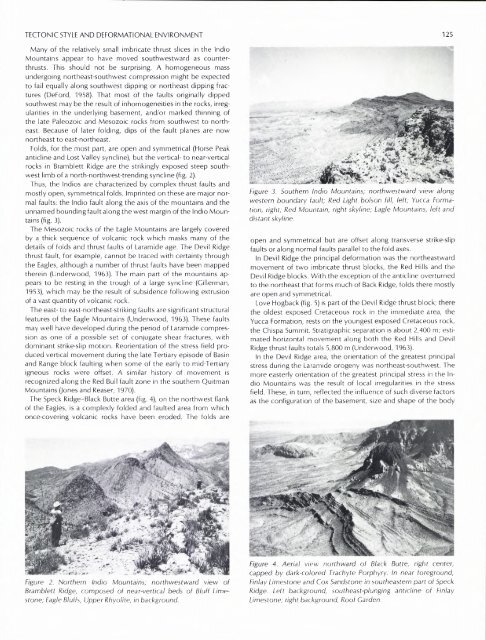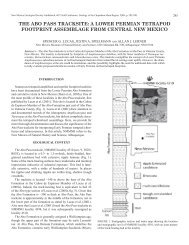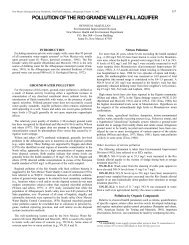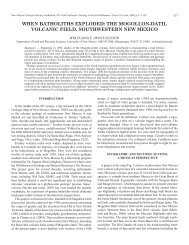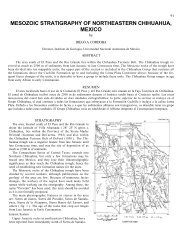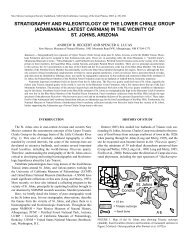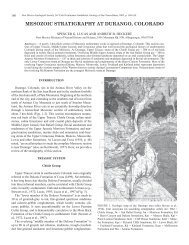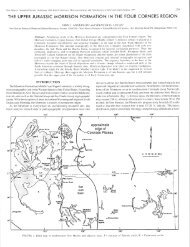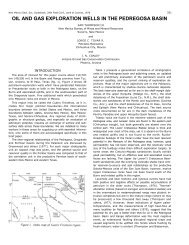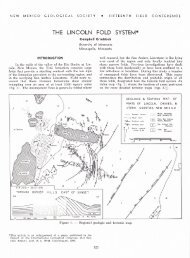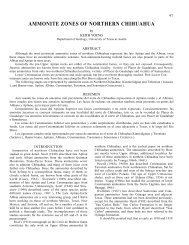Tectonic Style and Deformational Environment in the Eagle ...
Tectonic Style and Deformational Environment in the Eagle ...
Tectonic Style and Deformational Environment in the Eagle ...
Create successful ePaper yourself
Turn your PDF publications into a flip-book with our unique Google optimized e-Paper software.
TECTONIC STYLE AND DEFORMATIONAL ENVIRONMENT 125<br />
Many of <strong>the</strong> relatively small imbricate thrust slices <strong>in</strong> <strong>the</strong> Indio<br />
Mounta<strong>in</strong>s appear to have moved southwestward as counterthrusts.<br />
This should not be surpris<strong>in</strong>g. A homogeneous mass<br />
undergo<strong>in</strong>g nor<strong>the</strong>ast-southwest compression might be expected<br />
to fail equally along southwest dipp<strong>in</strong>g or nor<strong>the</strong>ast dipp<strong>in</strong>g fractures<br />
(DeFord, 1958). That most of <strong>the</strong> faults orig<strong>in</strong>ally dipped<br />
southwest may be <strong>the</strong> result of <strong>in</strong>homogeneities <strong>in</strong> <strong>the</strong> rocks, irregularities<br />
<strong>in</strong> <strong>the</strong> underly<strong>in</strong>g basement, <strong>and</strong>/or marked th<strong>in</strong>n<strong>in</strong>g of<br />
<strong>the</strong> late Paleozoic <strong>and</strong> Mesozoic rocks from southwest to nor<strong>the</strong>ast.<br />
Because of later fold<strong>in</strong>g, dips of <strong>the</strong> fault planes are now<br />
nor<strong>the</strong>ast to east-nor<strong>the</strong>ast.<br />
Folds, for <strong>the</strong> most part, are open <strong>and</strong> symmetrical (Horse Peak<br />
anticl<strong>in</strong>e <strong>and</strong> Lost Valley syncl<strong>in</strong>e), but <strong>the</strong> vertical- to near-vertical<br />
rocks <strong>in</strong> Bramblett Ridge are <strong>the</strong> strik<strong>in</strong>gly exposed steep southwest<br />
limb of a north-northwest-trend<strong>in</strong>g syncl<strong>in</strong>e (fig. 2).<br />
Thus, <strong>the</strong> Indios are characterized by complex thrust faults <strong>and</strong><br />
mostly open, symmetrical folds. Impr<strong>in</strong>ted on <strong>the</strong>se are major normal<br />
faults: <strong>the</strong> Indio fault along <strong>the</strong> axis of <strong>the</strong> mounta<strong>in</strong>s <strong>and</strong> <strong>the</strong><br />
unnamed bound<strong>in</strong>g fault along <strong>the</strong> west marg<strong>in</strong> of <strong>the</strong> Indio Mounta<strong>in</strong>s<br />
(fig. 3).<br />
The Mesozoic rocks of <strong>the</strong> <strong>Eagle</strong> Mounta<strong>in</strong>s are largely covered<br />
by a thick sequence of volcanic rock which masks many of <strong>the</strong><br />
details of folds <strong>and</strong> thrust faults of Laramide age. The Devil Ridge<br />
thrust fault, for example, cannot be traced with certa<strong>in</strong>ty through<br />
<strong>the</strong> <strong>Eagle</strong>s, although a number of thrust faults have been mapped<br />
<strong>the</strong>re<strong>in</strong> (Underwood, 1963). The ma<strong>in</strong> part of <strong>the</strong> mounta<strong>in</strong>s appears<br />
to be rest<strong>in</strong>g <strong>in</strong> <strong>the</strong> trough of a large syncl<strong>in</strong>e (Gillerman,<br />
1953), which may be <strong>the</strong> result of subsidence follow<strong>in</strong>g extrusion<br />
of a vast quantity of volcanic rock.<br />
The east- to east-nor<strong>the</strong>ast-strik<strong>in</strong>g faults are significant structural<br />
features of <strong>the</strong> <strong>Eagle</strong> Mounta<strong>in</strong>s (Underwood, 1963). These faults<br />
may well have developed dur<strong>in</strong>g <strong>the</strong> period of Laramide compression<br />
as one of a possible set of conjugate shear fractures, with<br />
dom<strong>in</strong>ant strike-slip motion. Reorientation of <strong>the</strong> stress field produced<br />
vertical movement dur<strong>in</strong>g <strong>the</strong> late Tertiary episode of Bas<strong>in</strong><br />
<strong>and</strong> Range block fault<strong>in</strong>g when some of <strong>the</strong> early to mid-Tertiary<br />
igneous rocks were offset. A similar history of movement is<br />
recognized along <strong>the</strong> Red Bull fault zone <strong>in</strong> <strong>the</strong> sou<strong>the</strong>rn Quitman<br />
Mounta<strong>in</strong>s (Jones <strong>and</strong> Reaser, 1970).<br />
The Speck Ridge-Black Butte area (fig. 4), on <strong>the</strong> northwest flank<br />
of <strong>the</strong> <strong>Eagle</strong>s, is a complexly folded <strong>and</strong> faulted area from which<br />
once-cover<strong>in</strong>g volcanic rocks have been eroded. The folds are<br />
Figure 2. Nor<strong>the</strong>rn Indio Mounta<strong>in</strong>s; northwestward view of<br />
Bramblett Ridge, composed of near-vertical beds of Bluff Limestone;<br />
<strong>Eagle</strong> Bluffs, Upper Rhyolite, <strong>in</strong> background.<br />
Figure 3. Sou<strong>the</strong>rn Indio Mounta<strong>in</strong>s; northwestward view along<br />
western boundary fault; Red Light bolson fill, left; Yucca Formation,<br />
right; Red Mounta<strong>in</strong>, right skyl<strong>in</strong>e; <strong>Eagle</strong> Mounta<strong>in</strong>s, left <strong>and</strong><br />
distant skyl<strong>in</strong>e.<br />
open <strong>and</strong> symmetrical but are offset along transverse strike-slip<br />
faults or along normal faults parallel to <strong>the</strong> fold axes.<br />
In Devil Ridge <strong>the</strong> pr<strong>in</strong>cipal deformation was <strong>the</strong> nor<strong>the</strong>astward<br />
movement of two imbricate thrust blocks, <strong>the</strong> Red Hills <strong>and</strong> <strong>the</strong><br />
Devil Ridge blocks. With <strong>the</strong> exception of <strong>the</strong> anticl<strong>in</strong>e overturned<br />
to <strong>the</strong> nor<strong>the</strong>ast that forms much of Back Ridge, folds <strong>the</strong>re mostly<br />
are open <strong>and</strong> symmetrical.<br />
Love Hogback (fig. 5) is part of <strong>the</strong> Devil Ridge thrust block; <strong>the</strong>re<br />
<strong>the</strong> oldest exposed Cretaceous rock <strong>in</strong> <strong>the</strong> immediate area, <strong>the</strong><br />
Yucca Formation, rests on <strong>the</strong> youngest exposed Cretaceous rock,<br />
<strong>the</strong> Chispa Summit. Stratigraphic separation is about 2,400 m; estimated<br />
horizontal movement along both <strong>the</strong> Red Hills <strong>and</strong> Devil<br />
Ridge thrust faults totals 5,800 m (Underwood, 1963).<br />
In <strong>the</strong> Devil Ridge area, <strong>the</strong> orientation of <strong>the</strong> greatest pr<strong>in</strong>cipal<br />
stress dur<strong>in</strong>g <strong>the</strong> Laramide orogeny was nor<strong>the</strong>ast-southwest. The<br />
more easterly orientation of <strong>the</strong> greatest pr<strong>in</strong>cipal stress <strong>in</strong> <strong>the</strong> Indio<br />
Mounta<strong>in</strong>s was <strong>the</strong> result of local irregularities <strong>in</strong> <strong>the</strong> stress<br />
field. These, <strong>in</strong> turn, reflected <strong>the</strong> <strong>in</strong>fluence of such diverse factors<br />
as <strong>the</strong> configuration of <strong>the</strong> basement, size <strong>and</strong> shape of <strong>the</strong> body<br />
•<br />
Figure 4. Aerial view northward of Black Butte, right center,<br />
capped by dark-colored Trachyte Porphyry. In near foreground,<br />
F<strong>in</strong>lay Limestone <strong>and</strong> Cox S<strong>and</strong>stone <strong>in</strong> sou<strong>the</strong>astern part of Speck<br />
Ridge. Left background, sou<strong>the</strong>ast-plung<strong>in</strong>g anticl<strong>in</strong>e of F<strong>in</strong>lay<br />
Limestone; right background, Roof Garden.<br />
Ew


